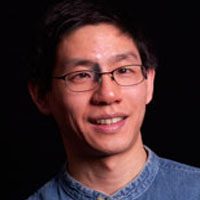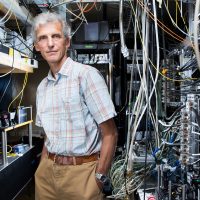- X. Shi, J. Sinanan-Singh, K. DeBry, S. Todaro, I. Chuang, and J. Chiaverini. Long-lived metastable-qubit memory. Phys Rev A, 111, February 2025.
- X. Shi, S. Todaro, G. Mintzer, I. Chuang, C. D. Bruzewicz, and J. Chiaverini. Ablation loading of barium ions into a surface-electrode trap. Applied Physics Letters, 122(264002), June 2023.
- K. DeBry, J. Sinanan-Singh, I. Chuang, C. Bruzewicz, D. Reens, M. Kim, M. P. Roychowdhury, R. McConnell, and J. Chiaverini. Experimental Quantum Channel Discrimination Using Metastable States of a Trapped Ion. Phys Rev Lett, 131(170602), October 2023.
- Z. Rossi, I. Chuang, John M. Martyn, and Andrew Tan. A grand unification of quantum algorithm. PRX Quantum, 2(040203), 2021.
- A. Dutt, I. Chuang, E. Pednault, Chai Wah Wu, Sarah Sheldon, John Smolin, and Lev Bishop. Active Learning of Quantum System Hamiltonians yields Query Advantage. ArXiv 2021.
- I. Chuang, D. T. C. Allcock, W. C. Campbell, J. Chiaverini, E. R. Hudson, I. D. Moore, A. Ransford, C. Roman, J. M. Sage, and D. J. Wineland. omg blueprint for trapped ion quantum computing with metastable states. Appl. Phys. Lett. , 119(214002), 2021.
- Z. Rossi and I. Chuang. Quantum hypothesis testing with group structure. Phys. Rev. A, 104(012425), July 2021.
- J. Stuart, I. Chuang, R. Panock, C.D. Bruzewicz, J.A. Sedlacek, R. McConnell, J.M. Sage, and J. Chiaverini. Chip-Integrated Voltage Sources for Control of Trapped Ions. Phys. Rev. Applied, 11(024010), 2019.
- R. Rines, I. Chuang, and Kevin Obenland. Empirical determination of the simulation capacity of a near-term quantum computer. ArXiv 2019.
- I. Chuang, Michael F. O'Keeffe, Lior Horesh, John F. Barry, and Danielle A. Braje. Hamiltonian engineering with constrained optimization for quantum sensing and control. New J. Phys, 21(023015), 2019.
- I. Chuang, Catherine Medlock, Alan Oppenheim, and Qi Ding. Operating Characteristics for Binary Hypothesis Testing in Quantum Systems. Annual Allerton Conference on Communication, Control, and Computing (Allerton), 1136-1145, 2019. IEEE.
- Y. Niu, I. Chuang, and Sirui Lu. Optimizing QAOA: Success Probability and Runtime Dependence on Circuit Depth. ArXiv 2019.
- R. Rines, I. Chuang, Thomas Monz, Daniel Nigg, Matthias F. Brandl, and Philipp Schindler. Realization of a scalable Shor algorithm. Science, 351:6277, 2016.
- A. Eltony, D. Gangloff, M. Shi, A. Bylinskii, V. Vuletic, and I. Chuang. Technologies for trapped-ion quantum information systems. Quantum Information Processing , 15, December 2016.
- G. Low and I. Chuang. Quantum Imaging by Coherent Enhancement. Physical Review Letters, 114:100801, 2015.
- G. Low and I. Chuang. Fixed-Point Quantum Search with an Optimal Number of Queries. Physical Review Letters A, 113:210501, 2014.
- I. Chuang, H. Park, and Jing Kong. Motional heating in a graphene-coated ion trap. Nano Lett, 14 (10):5712-5716, 2014.
- X. Chen, B. Zeng, and I. Chuang. Nonbinary codeword-stabilized quantum codes. Physical Review A - Atomic, Molecular, and Optical Physics, 78:6, 2014.
- G. Low and I. Chuang. Optimal arbitrarily accurate composite pulse sequences. Physical Review A, 89:022341, 2014.
- G. Low and I. Chuang. Quantum inference on Bayesian networks. Physical Review A, 89:062315, 2014.
- B. Zeng, X. Chen, and I. Chuang. Semi-Clifford operations, structure of C k hierarchy, and gate complexity for fault-tolerant quantum computation. Physical Review A, 77:042313, 2014.
- X. Chen, B. Zeng, I. Chuang, and A.W. Cross. Subsystem stabilizer codes cannot have a universal set of transversal gates for even one encoded qudit. Physical Review A - Atomic, Molecular, and Optical Physics, 78:1, 2014.
- I. Chuang and Jungsang Kim. Surface-electrode point Paul trap. Physical Review A, 82:04312, 2014.
- C. Chudzicki, I. Chuang, and Jeffrey H. Shapiro. Deterministic and cascadable conditional phase gate for photonic qubits. Physical Review A atomic, molecular, and optical physics, 87:042325, 2013.
- R. Clark, I. Chuang, Z. Lin, and Kenan S. Diab. A cryogenic surface-electrode elliptical ion trap for quantum simulation. Journal of Applied Physics, 109:7, 2011.
- I. Chuang. Finite-geometry models of electric field noise from patch potentials in ion traps. Phys. Rev. A, 84:053425, 2011.
- I. Chuang and Nathan S. Lachenmyer. Laser-induced charging of microfabricated ion traps. J. Appl. Phys., 110:104901, 2011.
- M. Shi, Y. Ge, M. Cetina, and I. Chuang. Microfabricated surface ion trap on a high-finesse optical mirror. Opt. Lett., 36:3045-3047, 2011.
- I. Chuang. Surface-electrode ion trap with integrated light source. Appl. Phys. Lett., 98:214103, 2011.
- X. Chen, B. Zeng, I. Chuang, Zheng-Cheng Gu, and Xiao-Gang Wen. Tensor product representation of a topological ordered phase: Necessary symmetry conditions. Phys. Rev. B, 82:165119, 2010.
- R. Clark, I. Chuang, Tongyan Lin, and K.R. Brown. A Two-Dimensional Lattice Ion Trap for Quantum Simulation. J. Appl. Phys., 105:013114, 2009.
- V. Vuletic, I. Chuang, and J. Labaziewicz. Cavity Sideband Cooling of a Single Trapped Ion. Phys. Rev. Lett., 102:103001, 2009.
- X. Chen, B. Zeng, B. Yoshida, I. Chuang, and Zheng-Cheng Gu. Gapped Two-body Hamiltonian Whose Unique Ground State is Universal for One-Way Quantum Computation. Phys. Rev. Lett., 102:220501, 2009.
- S. Wang, Y. Ge, I. Chuang, J. Labaziewicz, and R. Shewmon. Individual addressing of ions using magnetic field gradients in a surface-electrode ion trap. App. Phys. Lett., 94:094103, 2009.
- B. Zeng, X. Chen, and I. Chuang. Semi-Clifford operations, structure of Ck hierarchy, and gate complexity for fault-tolerant quantum computation. Phys. Rev. A, 77:042313, 2008.
- Y. Ge, P. Antohi, D. Leibrandt, I. Chuang, J. Labaziewicz, and K.R. Brown. Suppression of Heating Rates in Cryogenic Surface-Electrode Ion Traps.. Phys. Rev. Lett., 100:13001, 2008.
- M. Cetina, A. Grier, I. Chuang, V. Vuletic, and J. Campbell. Bright Source of Cold Ions for Surface-Electrode Traps.. Phys. Rev. A, 76:41401, 2007.
- I. Chuang, J. Labaziewicz, Philip Richerme, K.R. Brown, and Kazuhiro Hayasaka. Compact, filtered diode laser system for precision Spectroscopy.. Opt. Lett., 32:572-574, 2007.
- D. Leibrandt, R. Clark, P. Antohi, W. Bakr, I. Chuang, J. Labaziewicz, and K.R. Brown. Laser Ablation Loading of a Surface-Electrode Ion Trap.. Phys. Rev. A, 76:55403, 2007.
- R. Clark, I. Chuang, K.R. Brown, J. Labaziewicz, and P. Richerme. Loading and Characterization of a Printed-Circuit-Board Atomic Ion Trap.. Phys. Rev. A, 75:15401, 2007.
- B. Zeng, I. Chuang, and A.W. Cross. Local Unitary Versus Local Clifford Equivalence of Stabilizer and Graph States. Phys. Rev. A, 75:32325, 2007.
- I. Chuang, D. Bacon, and A. W. Harrow. Efficient Quantum Circuits for Schur and Clebsch-Gordon Transforms. Phys. Rev. Lett., 97:179592, 2006.
- D. Leibrandt, W. Bakr, I. Chuang, C. E. Pearson, W. J. Mallard, and K.R. Brown. Experimental investigation of planar ion traps. Phys. Rev. A, 73:32307, 2006.
- I. Chuang, H.B. Heersche, Z. de Groot, J.A. Folk, L.P. Kouwenhoven, H.S.J. van der Zant, A.A. Houck, and J. Labaziewicz. Kondo effect in the presence of magnetic impurities. Phys. Rev. Lett., 96:017205, 2006.
- R. Clark, I. Chuang, and K.R. Brown. Limitations of quantum simulation examined by simulating a pairing hamiltonian using nuclear magnetic resonance. Phys. Rev. Lett., 97:050504, 2006.
- B. Zeng, I. Chuang, and A.W. Cross. Transversality versus Universality for Additive quantum codes. preprint: arXiv:0706.1382 2006.
People: Isaac L. Chuang
Associate Professor of Electrical Engineering and Associate Professor of Physics


